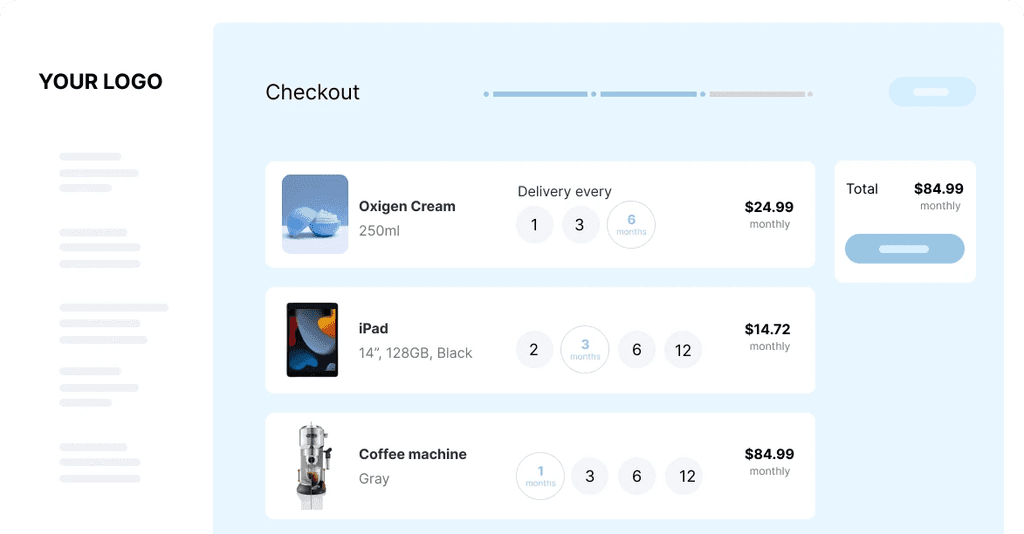Ultimate Guide to Recurring Revenue Business Models: Proven Strategies for Sustainable Growth
Flor Bermúdez

Feb 5, 2025
Understanding Modern Recurring Revenue Models That Work

Businesses are moving away from one-time sales toward models based on ongoing customer relationships and regular payments. This shift creates steady income while building stronger connections with customers. The key is finding the right approach that works for your specific business and customers.
Types of Recurring Revenue Models
There are several proven ways to generate recurring revenue. Subscription boxes bring curated products to customers' doors on a regular schedule, making shopping effortless and fun. Membership programs give people special access to content, services or communities they value. Subscription services like software platforms and streaming media provide continuous access to digital tools and entertainment that customers use daily.
Key Benefits of Recurring Revenue
Beyond just steady cash flow, these models offer major advantages. They allow businesses to predict future revenue more accurately, which helps with planning and investing wisely. The ongoing relationship also provides deep insights into what customers want and need. Companies can use this data to improve their offerings and keep customers happy long-term.
The shift to recurring revenue is happening across many industries. Research from CFO Research and Salesforce found that 52% of finance leaders say at least 40% of their revenue now comes from recurring sources. This spans everything from software to supplements to industrial equipment. See the full research report here. The growth of cloud services and connected devices is helping more businesses make this transition. Want to learn more? Check out this guide on mastering subscriptions on Shopify.
Examples of Successful Implementations
Many companies show how well these models can work in different industries. Dollar Shave Club changed the razor business by delivering affordable blades on subscription. Adobe moved from selling software once to providing ongoing Creative Cloud access with regular updates. These real examples prove that recurring revenue can work for both physical products and digital services when done thoughtfully.
Building Your Operational Foundation for Success
A strong operational base is essential for any business, particularly those running on recurring revenue models. Your business needs well-designed systems and processes that complement each other - from team structure to customer interactions. The key is building operations that can grow with your business.
Aligning Your Teams for Recurring Revenue Success
Getting your teams to work together is step one. Sales, Marketing, and Customer Success need shared objectives and ways to measure progress. When teams are in sync, customers get a smooth, consistent experience. For example, if Marketing highlights a specific product feature, Sales should be ready to explain its benefits, while Customer Success provides ongoing feature support. This matters because most of the customer value comes after the initial sale in recurring revenue businesses. Learn more about managing recurring revenue at Salesforce's Revenue Lifecycle Guide.
Making Billing and Pricing Work Better
Your billing system needs to be simple and reliable. When billing gets complicated, customers get frustrated and may leave. That's why it's worth investing in good billing software that can handle growth. Your pricing also needs careful thought - it should match what competitors charge while reflecting your true value. Consider offering different price levels or usage-based options to meet various customer needs.
Creating Smoother Workflows
Good workflows help recurring revenue businesses run better. When you automate things like sending invoices, payment reminders, and getting new customers started, your team can focus on more important work. Regular workflow reviews help catch and fix problems early.
Avoiding Common Problems
Running a recurring revenue business comes with challenges. Teams might not communicate well, billing can get messy, and systems might not work together properly. The solution? Keep checking your processes, ask customers and employees for feedback, and be ready to change when needed. A solid operation helps your business succeed long-term.
Creating a Customer Acquisition Engine That Delivers

Getting new customers is essential for any business, but especially for those with subscription-based models. Companies need a steady flow of new subscribers to make up for those who leave and keep growing. Building an effective system to attract customers is a must-have, not a nice-to-have.
Understanding Your Ideal Customer
Success starts with really knowing who you want to reach. Think about it - a monthly pet supply box needs different marketing than business software. When you understand your perfect customer's age, problems, and online habits, you can speak their language and find them where they already spend time. This focused approach helps you attract customers who are more likely to sign up and stick around.
Crafting a Compelling Value Proposition
Once you know your customer, you need to show them why they should choose you. Don't just list what your product does - explain how it makes their life better. Does it save them money? Fix an annoying problem? Give them something they can't get elsewhere? Your core message should clearly communicate these benefits across all your marketing.
Designing a Frictionless Onboarding Experience
The first impression matters a lot. If signing up is confusing or complicated, potential customers will leave. Make it easy by simplifying checkout, providing clear directions, and offering help when needed. When customers have a smooth start, they're more likely to become long-term subscribers.
Building Trust Through Content Marketing
Quality content helps attract and engage potential customers naturally. By sharing helpful blog posts, videos, or webinars, you establish expertise and build trust. For instance, a meal delivery service might share recipes and cooking guides. This helps people while subtly showing the value of your service. Good content turns browsers into buyers by proving you understand their needs.
Managing Customer Acquisition Cost (CAC)
While getting new customers is vital, you need to watch your spending. High acquisition costs can hurt your profits, especially with subscription businesses. Smart companies track exactly what they spend to get each customer and constantly improve their methods. They test different marketing channels, target more precisely, and work to convert more visitors into customers. Keeping costs in check while growing your customer base is key to lasting success.
Maximizing Customer Lifetime Value Through Strategic Engagement
Building lasting customer relationships directly impacts recurring revenue growth. The key is not just keeping customers satisfied, but guiding them to gain more value over time. This creates steady, predictable income that powers sustainable business expansion.
Building Products Customers Love
Creating essential products and services that customers rely on daily is crucial for maximizing lifetime value. This comes from consistently delivering real benefits that address customer problems effectively. For example, when software seamlessly connects with a customer's other key tools, it becomes an irreplaceable part of their process. Once customers are deeply integrated with your solution, they're much less likely to switch providers.
Growing Customer Accounts
The most successful recurring revenue businesses focus on expanding existing customer relationships. This means identifying natural opportunities to offer additional value through upgrades or complementary services. A subscription box company might add premium products or exclusive early access. Well-designed tiered pricing also lets customers access more capabilities as their needs grow over time.
Proactive Customer Support Matters
Helping customers succeed requires active engagement and support. This includes personalized onboarding, regular training sessions, and consistent check-ins to ensure they're getting maximum value. By investing in customer success programs, companies build loyalty and reduce cancellations. The result is higher customer lifetime value and better overall business health. Learn more about effective strategies in this guide: How to master customer lifetime value.
Building Strong Relationships That Last
Strong customer relationships lead to organic growth through referrals and word-of-mouth marketing. When customers genuinely value your service, they naturally recommend it to others. Effective relationship building includes personal communication, community engagement, and meaningful loyalty rewards. For instance, offering referral incentives encourages satisfied customers to bring in new subscribers. These combined approaches create sustainable growth by maximizing the long-term value of each customer relationship.
Mastering the Metrics That Drive Recurring Revenue Growth

Growing a business with recurring revenue requires a deep understanding of key performance metrics. By tracking and analyzing the right numbers, companies can make smart decisions that lead to steady, sustainable growth. Let's explore the most important metrics and how to use them effectively.
Essential Metrics for Recurring Revenue
Three core metrics stand out when measuring recurring revenue performance. First, Monthly Recurring Revenue (MRR) shows you exactly how much predictable income your business generates each month. Second, Customer Acquisition Cost (CAC) tells you how much you spend to bring in each new customer - a number that directly impacts your bottom line. Third, Churn Rate measures how many customers cancel their subscriptions, giving you clear feedback on customer satisfaction.
Using Metrics to Drive Actionable Insights
Simply collecting data isn't enough - successful companies use these metrics to spot problems and make improvements. For example, if you notice your churn rate going up, it might signal issues with your product or customer support that need fixing. Similarly, tracking your CAC helps you spend your marketing budget more wisely. Want to learn more about pricing strategies? Check out How to master subscription pricing strategies.
Building Effective Dashboards
A well-designed dashboard puts all your key metrics in one clear view. Include simple graphs that show trends in your MRR, CAC, and churn rate over time. Don't forget to track Customer Lifetime Value (CLTV) - knowing how much revenue each customer brings helps you decide where to focus your retention efforts and how to increase customer value over time.
Implementing Data-Driven Improvement Cycles
Making decisions based on data should be an ongoing process. Start by setting clear goals for your metrics. Then track your progress regularly and make changes based on what the numbers tell you. For example, if you want to reduce churn, look at why customers leave and create specific programs to keep them around longer. Keep testing and adjusting your approach based on results. This systematic method helps build a strong, predictable revenue stream that grows over time.
Scaling Your Recurring Revenue Model for Long-Term Success

Growing a business with recurring revenue requires careful planning and execution. The key is finding the right balance between rapid growth and maintaining excellent service quality that keeps customers happy. Smart businesses focus on strategic expansion while keeping their core strengths intact.
Expanding Into New Markets
Breaking into new markets can fuel significant growth. This could mean entering different geographic areas or serving new customer groups with specific needs. The key is making data-backed decisions by analyzing market size, competition levels, and customer acquisition costs. For instance, a pet subscription box company might start serving customers in a new country or create specialized boxes for specific dog breeds.
Developing Additional Revenue Streams
Adding new ways to generate income helps businesses grow sustainably. Companies can introduce complementary products, create different pricing tiers, or form strategic partnerships to reach more customers. For example, a software company might add professional services or create premium features for power users. This approach reduces dependence on a single income source.
Leveraging Automation Effectively
Smart automation helps businesses scale efficiently. By automating routine tasks like billing and customer onboarding, teams can focus on building relationships and improving services. This ensures consistent quality even as the customer base grows. Good automation also reduces mistakes and makes operations more reliable.
Maintaining Operational Excellence During Growth
As companies grow, keeping operations running smoothly becomes critical. This means improving workflows, upgrading systems, and building infrastructure that can handle more customers. For example, using reliable cloud services ensures systems stay responsive even during peak times. Regular process reviews help spot and fix issues before they affect customers.
Building Organizational Capabilities for Sustainable Scaling
Long-term success requires strong organization-wide capabilities. This means hiring great people, encouraging new ideas, and creating clear roles as the company grows. Only 24% of businesses currently use subscription models, making it essential to build teams that can adapt quickly to market changes. Good communication and empowered employees help maintain quality service during growth.
Sharpei can help your business handle these scaling challenges effectively. With flexible payment options for rentals, lease-to-own, and subscriptions, you'll have the tools needed to grow sustainably. Learn more about how Sharpei can help your business grow.
Related posts
Ready To Join The Circular Movement?
United for a smarter shopping experience and a better planet












